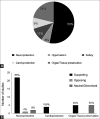A complete review of preclinical and clinical uses of the noble gas argon: Evidence of safety and protection
- PMID: 30971592
- PMCID: PMC6489383
- DOI: 10.4103/aca.ACA_111_18
A complete review of preclinical and clinical uses of the noble gas argon: Evidence of safety and protection
Abstract
The noble gas argon (Ar) is a "biologically" active element and has been extensively studied preclinically for its organ protection properties. This work reviews all preclinical studies employing Ar and describes the clinical uses reported in literature, analyzing 55 pertinent articles found by means of a search on PubMed and Embase. Ventilation with Ar has been tested in different models of acute disease at concentrations ranging from 20% to 80% and for durations between a few minutes up to days. Overall, lesser cell death, smaller infarct size, and better functional recovery after ischemia have been repeatedly observed. Modulation of the molecular pathways involved in cell survival, with resulting anti-apoptotic and pro-survival effects, appeared as the determinant mechanism by which Ar fulfills its protective role. These beneficial effects have been reported regardless of onset and duration of Ar exposure, especially after cardiac arrest. In addition, ventilation with Ar was safe both in animals and humans. Thus, preclinical and clinical data support future clinical studies on the role of inhalatory Ar as an organ protector.
Keywords: Argon; cardiac arrest; ischemia-reperfusion injury; neuroprotection.
Conflict of interest statement
None
Figures
Comment in
-
Argon: The Future Organ Protectant?Ann Card Anaesth. 2019 Apr-Jun;22(2):111-112. doi: 10.4103/aca.ACA_180_18. Ann Card Anaesth. 2019. PMID: 30971590 Free PMC article. No abstract available.
References
-
- Rayleigh L, Sec RS, Ramsay W. Argon, a new constituent of the atmosphere. Proc R Soc Lond. 1895;57:340–6.
-
- Material Safety Data Sheet Gaseous Argon, Universal Industrial Gases, Inc. [Last retrieved on 2013 Oct 14]. Available from: http://www.uigi.com/MSDS_gaseous_Ar.html .
-
- Roberts MW, Mathiesen KA, Ho HS, Wolfe BM. Cardiopulmonary responses to intravenous infusion of soluble and relatively insoluble gases. Surg Endosc. 1997;11:341–6. - PubMed
-
- Behnke AR, Yorarbrough OD. Respiratory resistance, oil-water solubility and mental effects of argon compared with helium and nitrogen. Am J Physiol. 1939;126:409–15.
Publication types
MeSH terms
Substances
LinkOut - more resources
Full Text Sources
Medical
Research Materials

